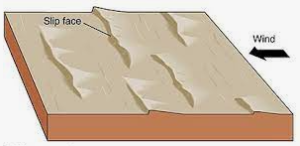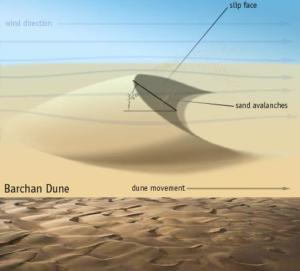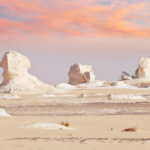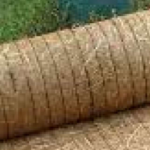Sand Dunes
The strong action of wind generally deposits sand in the form of mounds. These sand mounds are known as “Sand Dunes”. The sand traveling as a bed load in the wind accumulates wherever it meets any obstruction, such as a boulder or a bush. As the accumulation of sand grows, it traps even more sand. In this manner, dunes are created. Sand dunes have a gentle slope (5° – 15°) on the windward side and a steeper slope (20° – 30°) on the lee side. The height of sand dunes depends on the wind speed and the size of sand grains. Dunes of 30 meters in height are very common all through the globe. The sand dunes migrate slowly in the direction of wind movement. In some cases, they move as much as 20 meters per year. The migrating sand dunes may advance and cover farmland, erode cultivated lands, abrade crops, cover roads/railway tracks, etc. Sand dunes can be considered as a natural hazard. Their movement can be checked by planting vegetation. There are 4 types of sand dunes; (i) transverse dunes, (ii) barchans, (iii) longitudinal dunes, and (iv) complex dunes.
How are Sand Dunes Formed
The Sand dunes are formed when strongly blowing wind deposits sand on top of each other until a small mound starts to form. Once that first mound of sand forms, it starts piling up on the windward side more and more until the edge of the dune collapses under its own weight. The collapse begins when the angle of the dune becomes too large to support the weight of deposited grains. This is called the angle of repose and is usually around 30-34o, but depends on factors like grain size, wind speed, and roundedness of the individual grains. As these dunes collapse they start moving in the same direction as the wind, and if there is no wind moving in the opposite direction or there is no any obstacles in its path, barchan dunes are formed. These dunes are rare in the park as there are typically vegetation and complex wind patterns from multiple directions that prevent them from forming. As more barchan dunes are formed, they can move together and line up. This creates a transverse dune which is orientated perpendicular to the direction of wind and is one long ridge made up of many smaller barchan dunes. Another type of dune that travels is the parabolic dune. This dune type is similar to barchan dunes but instead forms around vegetation where the arms of the dune are anchored in place. In this park, parabolic dunes are scattered around the sand sheet slowly traveling toward the main dune field. Nebkha dunes are essentially parabolic dunes before traveling. They form when sand is trapped at the base of a plant and are able to build taller using the rigid plant structure as a strong foundation. The most complex dune type, which the park is known for is star dunes. These dunes form when complex wind patterns alternate direction and change the way sand is piled onto the dune. By changing wind direction, the sand piles up on multiple sides of the dune and is unable to reach the angle of repose so the dune never collapses. This is how the tallest dune at the park, known simply as the Star Dune, reached over 750 feet in height.
Role of Weathering and Erosion in Formation of Sand Dunes
Nothing has a greater impact on the landscape around us, especially in the Great Sand Dunes, than the processes of weathering and erosion. Typically seen as interchangeable words, these are actually two distinct processes in the world of geology. Weathering is the physical and/or chemical breakdown of surfaces due to wind, water, or ice. Erosion is the process of moving the broken down material from one place to another via wind, water, or gravity. At Great Sand Dunes National Park, erosion is responsible for recycling escaping sediments back into the main dune field and bringing in new sediments from the surrounding mountains. Alluvium, or sediments deposited by bodies of water, is the source most of the sand in the dunes.
Types of Sand Dunes
There are several types of sand dunes, each characterized by its distinct shape, formation, and orientation. The primary types of sand dunes include:
Transverse Dunes
Transverse dunes have their longer axis at right angles to the direction of the wind or have a perpendicular orientation to the prevailing wind direction. These dunes are broadly linear or crescentic in form. These dunes typically form in areas with abundant sand and a consistent wind direction. The wind blows sand grains across the landscape, and as the sand accumulates, it forms a ridge or crest perpendicular to the wind. Transverse dunes can also be defined as dunes characterized by slipfaces in one direction, representing a unidirectional wind regime (McKee 1979, p. 9). The term transverse in this sense can be used without strict regard to dune orientation.

The distinctive properties of these dunes are as under;
- Crest and Trough: Transverse dunes have a distinct crest and trough. The crest is the highest point of the dune, while the trough is the lowest point between the two crests.
- Perpendicular to Wind Direction: The most notable characteristic of transverse dunes is that they form at right angles to the prevailing wind direction. This is because the wind pushes the sand particles across the landscape, forming a ridge perpendicular to its path.
- Symmetrical Shape: Transverse dunes often have a symmetrical shape, with a gentle slope on the windward side (stoss side) and a steeper slope on the leeward side (lee side).
- Migration: These dunes can migrate or shift over time as a result of continued wind action. Sand is eroded from the windward side and deposited on the leeward side, causing the dune to advance in the direction of the wind.
- Common Environments: Transverse dunes are frequently found in deserts or arid regions where there is an ample supply of sand and a consistent wind direction. They can also occur in coastal areas where windblown sand from the beach forms dunes.
- Height and Size: The size and height of transverse dunes can vary, ranging from small ripples to large dune fields with towering crests.
The transverse dunes have an important role in shaping the landscape and directly influencing the ecosystem. They are dynamic features, constantly evolving as a result of wind and other environmental factors.
Barchans
The term was introduced in 1881 by Russian naturalist Alexander von Middendorf, based on their occurrence in Turkestan and other inland desert regions. Barchans are crescent-shaped or horseshoe-shaped dunes, the convex side of which faces the wind direction. The distinctive crescent shape is formed by the wind’s action, which predominantly blows in one direction. The horns or wings of the crescent point in the direction of wind flow. Barchans are formed where the wind is nearly unidirectional. They occur in groups in areas with the greatest sand supply. Barchan dunes have a gentle slope on the windward side (the side facing the wind) and a steeper slope on the leeward side (the side sheltered from the wind). The height of large dunes does not exceed 30 meters and their point-to-point length is generally 300 meters.

These dunes are fascinating features of arid landscapes, and their movement and shape are influenced by the complex interactions between wind, sand, and topography. Studying barchan dunes provides insights into the dynamics of wind-blown sand and the geomorphological processes shaping desert landscapes.
Some key characteristics of barchan dunes include:
- Crescent Shape: Barchan dunes have a characteristic crescent or U-shape with horns pointing downwind.
- Asymmetry: The windward side, or stoss side, is typically gentle and inclined, while the leeward side, or slip face, is steeper.
- Limited Size: Barchans are usually smaller compared to other types of dunes, with heights ranging from a few meters to around 30 meters.
- Migration: Barchan dunes are known for their ability to migrate across the landscape. The wind carries sand particles up the windward side and deposits them on the leeward side, causing the dune to move in the direction of the prevailing wind.
- Formation: Barchans form in areas with a limited and unidirectional wind flow. The wind picks up loose sand grains, lifts them into the air, and then deposits them on the dune, causing it to grow in the downwind direction.
Parabolic Dunes
In contrast to barchan dunes, parabolic dunes have their tips pointing into the wind. These dunes form in areas where there is plenty of vegetation. It is the vegetation that anchors parts of the sand, causing the U or V shape. Like the Barchan dunes, these dunes are also of a crescent/ horseshoe shape. The difference between the two is, that the horns or wings of the barchan dune point in the direction of wind flow, while the wings of a parabolic dune are facing the direction of wind.

We can distinguish a parabolic dune from the rest of the types on the basis of the following characteristics;
- Shape: The distinctive U or V shape is formed by the wind blowing sand in a concentrated manner. The tips of the dune arms are pointed in the downwind direction.
- Vegetation: Parabolic dunes often have vegetation growing on their surface, stabilizing the sand and preventing further movement. The vegetation, such as grasses or other plants, helps anchor the dune and prevents it from migrating further.
- Formation: Parabolic dunes often form in areas with loose, unconsolidated sand where the wind can easily transport and deposit sand particles. They are commonly associated with coastal environments and are influenced by both onshore and offshore winds.
- Blowout: The process of dune formation often starts with a blowout—a depression in the sand caused by the removal of sand by wind. As the wind continues to shape the dune, it takes on the characteristic U or V shape.
- Migration: While parabolic dunes can be stabilized by vegetation, they can also migrate over time if the vegetation cover is disrupted or if the wind direction changes.
Longitudinal Dunes
The dunes which are elongated in the wind direction, are called “longitudinal dunes”. Longitudinal dunes are found in various desert and coastal environments worldwide but are very common in the Arabian desert. In the Arab countries, these dunes are called “seifs” because they appear similar to an Arab sword. They are part of the dynamic and ever-changing landscapes shaped by wind-driven processes. These dunes usually develop in strong winds in areas where a small amount of sand is available. The longitudinal dunes may reach heights of 100 meters and may extend for about 90 kilometers. These dunes are distinct because of the following characteristics;
- Alignment: The dunes are aligned parallel to the direction of the prevailing wind. This alignment is a result of the constant transport of sand in the direction of the wind.
- Crests and Troughs: Longitudinal dunes have distinct crest lines and troughs. The windward side, facing the direction of the wind, is typically gentle and sloping, while the leeward side, sheltered from the wind, is steeper.
- Formation: These dunes form when there is a steady supply of sand and a consistent wind direction. As the wind transports sand, it accumulates on the windward side, building up the dune.
- Vegetation: Vegetation may play a role in stabilizing longitudinal dunes. Plant life can anchor the sand and prevent erosion, contributing to the formation and maintenance of these dunes.
- Sand Grain Size: The size of sand grains in longitudinal dunes can vary, but they are often medium to fine-grained.
Complex Dunes
In areas where the direction of wind varies, “complex dunes” are formed. They are of irregular shape.
to be continued……coming soon
Sources:
- McKee ED (1979) In: McKee ED (ed) A study of global sand seas. United States Government Printing Office, Washington
- Akram Jan Jaffar (2024), Great Sand Dunes National Park and Reserves


Leave a Reply